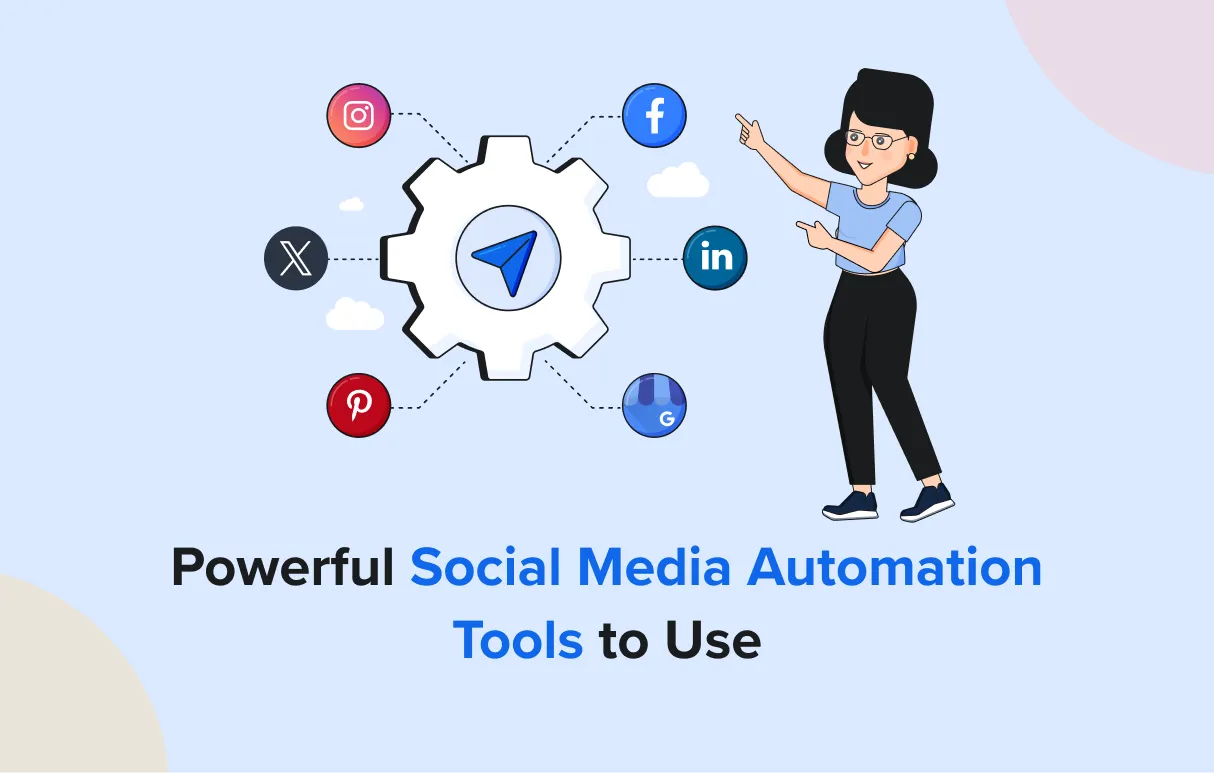Facebook in 2025 is buzzing with activity, according to Statista, 3 billion people scroll, share, and connect on the platform every month. Yet, for business pages, the reality is quite different. Average engagement has dropped to around 1.9% of reach and 0.15% of followers, according to DataReportal. Despite a platform full of potential customers, many posts struggle to generate meaningful likes, comments, or shares, showing that standing out now requires strategy and creativity.
That gap between huge audiences and tiny engagement is exactly why this topic matters now. If you’re a marketer, an agency, or a small business owner, you’ve probably felt the frustration: you post, you wait, and… crickets. The good news? Engagement isn’t dead – it’s just changed.
Simple: people don’t want to be sold to, they want to connect. They scroll past generic updates, but they stop for content that feels real, offers value, sparks a conversation, or makes them laugh, think, or share.
That’s where this guide comes in. We’ve pulled together 17 proven tips to boost your Facebook engagement in 2025 – simple, practical strategies that match how people are actually using Facebook today. Whether it’s mastering Reels, building stronger communities, or simply refining your writing style, these tactics will help you cut through the noise and connect with your audience in a way that lasts.
What is Facebook Engagement and How Do You Calculate It?
Before we jump into the strategies, let’s clarify what “Facebook engagement” really means. It’s the way people interact with your content, such as liking, commenting, sharing, saving, or even watching your videos all the way through.
On Facebook, engagement can include things like:
- Comments: Show how much your audience is engaging in conversations and sharing opinions.
- Shares: Indicate how much your content is valued and spread organically to new users.
- Saves: Reflect that followers find your content useful and want to revisit it later.
- Watch Time & Video Completion: Especially for Reels, Stories, and longer videos, these metrics indicate how compelling and engaging your content is.
- Click-Through Rates (CTR): Track how effectively your posts drive traffic to your website, landing pages, or other content.
- Reactions (Likes, Loves, etc.): While still useful, these are now secondary signals compared to meaningful interactions, such as comments, shares, and saves.
- Engaged Followers: Monitor how many of your followers actually interact with your content, not just see it.
So, every time someone does more than just scroll past your post, that’s engagement. Marketers often use the “engagement rate” as a way to measure the effectiveness of their content.
The most common formula is:
Engagement Rate (%) = (Total Engagements ÷ Total Reach) × 100
Whereas, total engagement = Likes + Shares + Comments + Save
17 Actionable Tips to Boost Facebook Engagement in 2025
If your Facebook posts aren’t getting the likes, comments, or shares you expect, chances are they’re not reaching the right people. And the reasons can vary. Maybe you’re posting when your audience isn’t online. Maybe your captions aren’t grabbing attention. Sometimes it’s the algorithm holding you back, other times it’s simply that the content isn’t offering enough value.
Whatever the case, the good news is that engagement isn’t out of reach. Once you understand who your audience is and what they care about, you can adjust your approach and start creating content that resonates.
Here are proven tips to boost your Facebook engagement in 2025 – practical tactics that will help your business page cut through the noise and actually connect with your followers.
1. Go All-In on Short-Form Video (Reels & Stories)
If there’s one format Facebook is prioritizing in 2025, it’s short-form video – Reels and Stories. These formats consistently get higher reach and watch time than static posts and are more likely to appear in your audience’s feed. They also act as powerful top-funnel content, helping businesses reach and attract new audiences.
Investing in short-form video isn’t just following a trend; it aligns with how Facebook users consume content today. According to EMARKETER, users spend 40% of their time on videos, and Facebook video posts can achieve engagement rates of up to 6%, the highest among all other formats. And if you’re specifically looking for more comments, Stories have the highest comment rate (0.06 – 0.10 %) on Facebook after live video, according to the Socialinsider benchmark report.
The key is to grab attention within the first few seconds and give viewers a reason to watch, comment, or share.
How to get more engagement and reach on videos and stories?
- Hook viewers immediately: Grab attention in the first 2-3 seconds with a bold statement, question, or visually striking moment.
- Ideal length: Keep Reels between 15-30 seconds for maximum watch-through, and Stories around 5-10 seconds per slide. Shorter videos perform better for repeat views and higher engagement.
- Captions and text overlays: Many users watch videos without sound, so adding captions ensures your message is understood and keeps viewers engaged.
- Use trending elements in stories: Incorporating popular music, stickers, and effects in your videos can boost discoverability, but make sure they align with your brand and message.
- Experiment with creative formats: Try different angles, transitions, pacing, or visual styles. Small adjustments can make a big difference in engagement.
- Analyze and replicate: Track which Reels or Stories get the most views, shares, and comments. Use these insights to guide future content, as a study by Statista shows that data-driven strategies can increase engagement by 32% on average.
- Optimize thumbnails and cover images: A compelling cover can increase click-through and watch time. Test different visuals to see which performs best. Boost engagement by testing different thumbnails, cover images, and captions for your Reels, Stories, or posts. Small tweaks can make a big difference in capturing attention. Facebook also offers AI-driven A/B testing, which automatically evaluates variations of captions, descriptions, and cover images to show the version that performs best with your audience.
- Call to action: Encourage viewers to comment, share, or swipe up (if applicable) to keep them interacting with your content.
For instance, Intel uses Reels to simplify product storytelling in a fun, engaging way that drives both views and brand recall.
2. Host Live Videos & Interactive Sessions
Live videos on Facebook consistently generate higher engagement than any other post type — likes, comments, and shares all spike during real-time broadcasts. Why? Because live video creates a sense of urgency and authenticity. In fact, 37% of viewers consider live video the most engaging type of content on their social media feeds (as per Restream report).
Viewers know it’s happening in the moment, which encourages them to stop scrolling and participate. They can comment, ask questions, and interact directly with your brand, making it feel personal and highly engaging.
Why Live Videos Get More Engagement?
- Real-Time Interaction: Viewers can comment and react instantly, and hosts can respond in real-time, creating a back-and-forth conversation.
- Authenticity and Trust: Live video is raw and unpolished, which builds credibility and humanizes your brand.
- Notification Boost: Facebook alerts followers when a page goes live, increasing the likelihood that your audience will join immediately.
- Longer Watch Time: Live sessions naturally keep viewers on the platform longer, boosting reach and engagement metrics.
How Businesses Can Use Live Videos?
- Q&A Sessions: Answer customer questions in real-time to address concerns and showcase expertise.
- Product Demos or Tutorials: Showcase products in action, demonstrate key features, or guide viewers through step-by-step instructions.
- Behind-the-Scenes Content: Offer a glimpse of your team, office, or production process to make your brand relatable.
- Webinars or Events: Host educational sessions that provide value while interacting with viewers.
- Live Polls and Contests: Encourage viewers to participate and react, which increases engagement and shares.
Tips for Maximum Engagement:
- Start Strong: Open with a compelling hook to grab attention within the first 30 seconds.
- Invite Interaction Early: Ask questions or encourage comments right from the start.
- Keep It Consistent: Schedule live sessions regularly so followers know when to tune in.
- Promote in Advance: Announce your live session days before to ensure more people join.
- Follow Up: Share highlights, clips, or recordings to continue engagement after the session ends.
Many brands, such as GoPro, Nike, and OnePlus, leverage Facebook Live to share product updates, Q&A sessions, new launches, and other events. These live sessions create hype on social media, drive high engagement, and boost conversions.
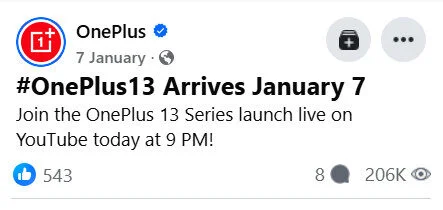
When done right, live videos can turn passive followers into active participants, increase reach, and strengthen your community. It’s a powerful tool for any business page looking to grow engagement in 2025.
3. Build and Nurture Facebook Groups or Communities
If you want to take engagement to the next level, nothing beats creating a Facebook Group or community around your brand or niche. Unlike regular page posts, groups foster closer connections and meaningful conversations because members feel like they’re part of an exclusive space where their opinions matter.
Why Groups Boost Engagement?
- Direct Access to Conversations: In a group, every post is visible to genuinely interested members, leading to more comments, discussions, and interactions.
- Stronger Sense of Community: People are more likely to engage when they feel like they belong to a group, not just a faceless audience.
- Organic Reach Advantage: Group posts tend to reach more members than page posts reach followers, since Facebook prioritizes active, engaged communities.
- Valuable Feedback Loop: Groups enable you to gain direct insights into customer needs, questions, and preferences, which is perfect for shaping content or products.
How Businesses Can Use Groups Effectively?
- Create a Niche Group: Focus on a specific topic, product, or audience segment. For example, a fitness brand could create a “Home Workout Tips” community.
- Encourage Interaction: Post questions, polls, challenges, and discussion prompts to spark conversations.
- Exclusive Content: Share behind-the-scenes updates, early product releases, or tips only available in the group.
- Moderate, Don’t Micromanage: Guide conversations gently, highlight valuable posts, and keep the group positive and on-topic.
- Recognize Members: Feature active members, celebrate milestones, or create badges to reward engagement.
For example, the iPhone has thousands of fan communities and groups that help build brand loyalty, spark conversations, and consistently engage users on Apple’s posts.
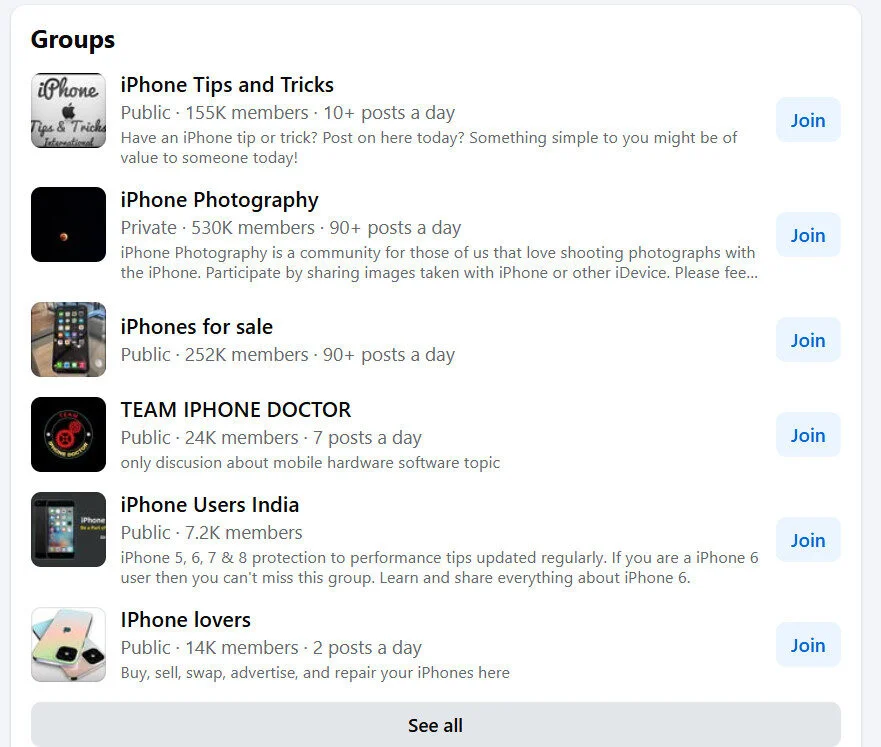
By creating and nurturing communities, your brand can turn followers into loyal advocates who actively participate, share, and promote your page, driving engagement far beyond what standard posts can achieve. If you want to learn more about building and nurturing Facebook communities, check out our detailed guide on Facebook community engagement tips.
One of the easiest ways to spark more engagement on Facebook is by letting people see the human side of your brand. Followers don’t just want polished ads – they want stories, personalities, and real moments they can connect with. Authentic content naturally encourages likes, comments, and shares because it feels genuine rather than promotional.
How it boosts engagement:
- Authenticity builds trust: People engage more when they believe your brand is transparent.
- Relatability drives comments: When followers see your challenges or day-to-day life, they’re more likely to respond and share their own experiences.
- Exclusivity sparks interaction: Sneak peeks or behind-the-scenes updates make fans feel like insiders, motivating them to react and participate.
There are many brands that share raw, behind-the-scenes content, and people love it. For example, Warby Parker.
When people feel like they’re part of your journey, they’re much more likely to stop scrolling, leave a comment, or hit share, exactly the kind of engagement your Facebook page needs.
5. Post Educational, Entertaining, or Inspirational Content
If your Facebook posts sound like ads, chances are people will scroll right past them. What really sparks engagement is value-driven content – something that teaches, entertains, or inspires your audience. When people learn something new, laugh at something relatable, or feel inspired, they’re far more likely to react, comment, and share.
How it boosts engagement:
- Educational content (how-tos, quick tips, guides) encourages saves and shares because people see it as useful.
- Entertaining content (memes, fun reels, relatable jokes) draws reactions and comments since it connects emotionally.
- Inspirational content (quotes, success stories, motivational posts) often gets shared widely, extending your reach.
For example, HubSpot is a page known for sharing marketing content in easy-to-understand language and engaging graphics that not only increase engagement but also keep audiences coming back.

By focusing on value first, you turn your Facebook page into a resource people actually want to interact with, not just another feed filled with ads.
Tip: Follow the 80/20 rule, make 80% of your content valuable (educational, entertaining, inspirational) and only 20% promotional. The more value people get from your posts, the more likely they are to stick around and engage consistently.
6. Encourage Conversations with Questions, Polls, Quizzes, and Contests
One of the simplest ways to get more engagement on Facebook is to ask for it. Instead of just broadcasting updates, invite your audience to join the conversation. When people respond, Facebook’s algorithm takes notice. The more comments, votes, and interactions your posts receive, the greater the reach of your page becomes.
How it boosts engagement:
- Questions spark conversations: Open-ended questions encourage followers to share opinions and personal stories, which drives comments.
- Polls and quizzes invite quick responses: Low-effort interactions, such as tapping an option in Stories or voting in a poll, boost engagement rates dramatically.
- Contests create excitement: Asking people to “comment to enter” or “share to win” generates a surge of interaction and visibility.
- Replying keeps the momentum going: Responding quickly to comments not only builds relationships but also signals higher engagement to Facebook’s algorithm, helping your post travel further.
Mix light, fun prompts with more meaningful questions. Not every post has to be deep; sometimes a playful quiz gets as much engagement as a serious industry discussion.
When you make your audience feel heard and involved, you’re no longer just posting at them; you’re building a two-way conversation that fuels stronger engagement.
7. Use High-Quality Visuals & Storytelling (While Sticking to Your Niche)
On Facebook, it’s not enough to simply post frequently; the content itself must stand out in the feed. High-quality visuals paired with strong storytelling are what stop the scroll and keep people hooked. And when you consistently tie those visuals back to your niche, you attract the right audience that’s more likely to engage with your content.
How it boosts engagement:
- Strong visuals grab attention: Clear, eye-catching graphics, photos, or carousels make people pause instead of scrolling past.
- Storytelling drives emotion: A short caption that tells a relatable story creates a deeper connection and encourages comments or shares.
- Consistency builds recognition: Sticking to your niche ensures your audience knows what to expect, making them more likely to interact regularly.
Quick tips for better visuals & storytelling:
- Use clear, high-resolution images – blurry or cluttered posts turn people away.
- Keep captions concise and conversational, while incorporating a storytelling element.
- Stick to a consistent visual style (colours, fonts, tone) so your content feels cohesive.
- Always tie posts back to your niche – relevant, focused content gets higher engagement than random off-topic posts.
For example, you can visit Patagonia’s Facebook page to see how they use high-quality visuals with short storytelling to hook scrollers.
When visuals and storytelling work together, your posts become both attention-grabbing and memorable, making it far more likely that people will engage, comment, and share.
8. Jump on Trends and Timely Topics (Moment Marketing)
One of the fastest ways to boost engagement on Facebook is by tapping into what’s already trending. Whether it’s a meme, breaking news, or a cultural moment, people are more likely to engage with content that feels current and relevant. This approach, often referred to as moment marketing, enables your brand to capitalize on the conversations your audience is already having.
How it boosts engagement:
- Relevance increases visibility: Posts tied to trending topics are more likely to be shared, commented on, and discovered.
- Memes spark relatability: Using humour and familiar formats makes your brand more approachable and encourages reactions.
- Timeliness builds credibility: Showing you’re in tune with the world makes followers see your brand as fresh and responsive.
Remember how Samsung reacted when Apple launched the iPhone 17? Samsung jumped into the conversation with clever content, aligning with what everyone was talking about. It’s a perfect example of hopping on moment marketing: timely, relevant, and immediately engaging.

Quick tips for trend-based content:
- Move fast – trends fade quickly, so timing is everything.
- Stay aligned with your brand voice; don’t jump on every trend just for attention.
- Keep posts light, engaging, and shareable to maximize reach.
By weaving your brand into cultural conversations, you make your Facebook page feel alive, relatable, and worth engaging with, exactly what followers want in their feeds.
9. Boost Top-Performing Posts with Paid Ads
Not every post needs an ad budget, but when you see a piece of content performing well organically, that’s your cue to give it a boost. Paid promotion works best when you amplify posts that are already resonating with your audience, because Facebook’s algorithm recognizes the engagement and pushes it further.
How it boosts engagement:
- Maximizes momentum: A post that’s gaining likes and comments naturally will get even more traction when shown to a wider audience (as per Facebook post boost guide).
- Reaches the right people: Boosted posts can be targeted by location, interests, or demographics to make sure the most relevant users see it.
- Creates social proof: Higher visibility means more likes, shares, and comments, which makes the post even more appealing to new viewers.
How to do it effectively:
- Track which posts are performing best (look for high organic reach, shares, or comments).
- Boost those posts with a small budget to expand their reach.
- Use audience targeting to reach people similar to your followers or custom audiences (e.g., website visitors or email subscribers).
- Set clear goals, whether it’s engagement, traffic, or conversions, so you know what success looks like.
As you can see below, how a business boosts a post when it gets the best organic engagement:
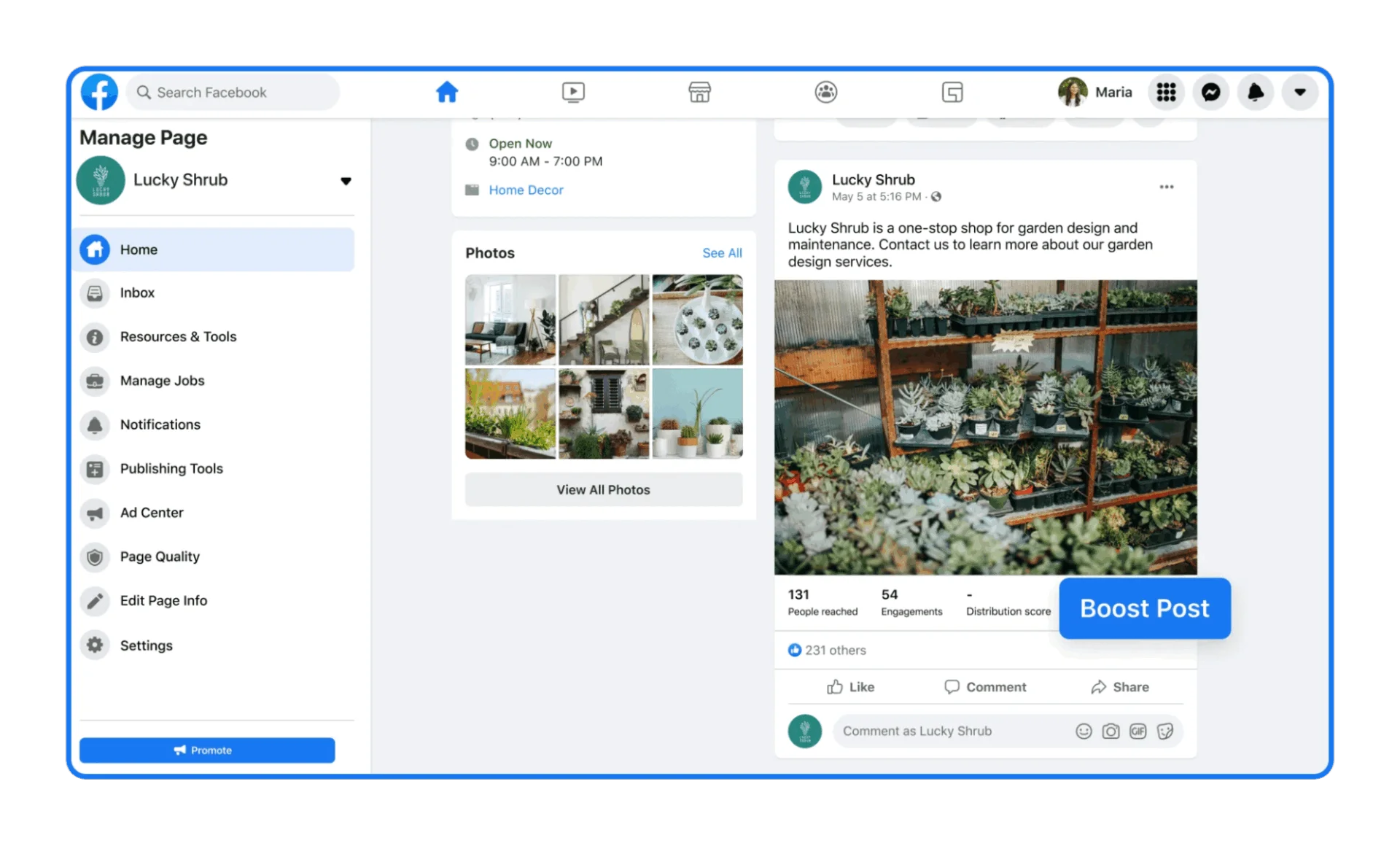
By combining organic momentum with paid reach, you can elevate a high-performing post into a major engagement driver for your Facebook page.
10. Maintain a Consistent Posting Schedule
If you want to build and keep engagement on Facebook, consistency is key. Posting randomly makes it harder for your audience to know when to expect you, but a steady rhythm creates a habit. When followers regularly see your content in their feed, your brand stays top-of-mind and your posts are more likely to spark interaction.
Why consistency matters:
- Builds anticipation: Audiences come to expect and look forward to your posts.
- Signals reliability: A consistent page feels more professional and trustworthy.
- Keeps the algorithm happy: Regular posting increases the chances your content will be surfaced to followers.
The Golden Rule: Post less, but post better. Instead of pushing out content just to stay active, focus on quality over quantity. A few strong posts per week that spark comments, shares, or clicks will perform far better than daily filler posts that people ignore.
Tips for staying consistent:
- Create a simple content calendar to plan posts in advance.
- Test different posting frequencies (like 3-4 times per week) and track what drives the most engagement.
- Mix formats (Reels, Stories, carousels, Lives) to keep content fresh without overwhelming your audience.
- Stay flexible; if a timely opportunity arises, adjust your schedule to take advantage of it.
Consistency doesn’t mean posting constantly; it means showing up regularly with valuable, engaging content that your followers actually want to interact with. You can also download free social media calendar templates to plan and stay consistent without the stress of last-minute posting.
11. Optimize Posting Times Using Insights
Even the best content can flop if it goes live when your audience isn’t around to see it. That’s why timing matters. Facebook Insights (or Meta Business Suite) shows you when your followers are most active, and posting during those windows can dramatically increase likes, comments, and shares.
Why timing boosts engagement:
- More eyes on your content: Posts that land when people are online get immediate reactions, which tells Facebook’s algorithm the content is valuable.
- Faster momentum: Early engagement in the first hour often determines how widely a post gets distributed.
- Better consistency: Aligning posts with audience activity creates a rhythm that your followers expect to see from you.
How to do it effectively:
- Check Insights to find the days and times when your audience is most active.
- Experiment with different posting times, such as mornings, lunch breaks, and evenings, to see what sparks the best engagement.
- Use scheduling tools in Meta Business Suite to line up posts at peak hours without manually posting.
- Revisit Insights monthly, audience behaviour changes, and your timing strategy should evolve too.
While every audience is unique, studies show certain days and time slots consistently generate higher engagement on Facebook. After studying thousands of accounts, SocialPilot found out the best times to post on Facebook for each day.
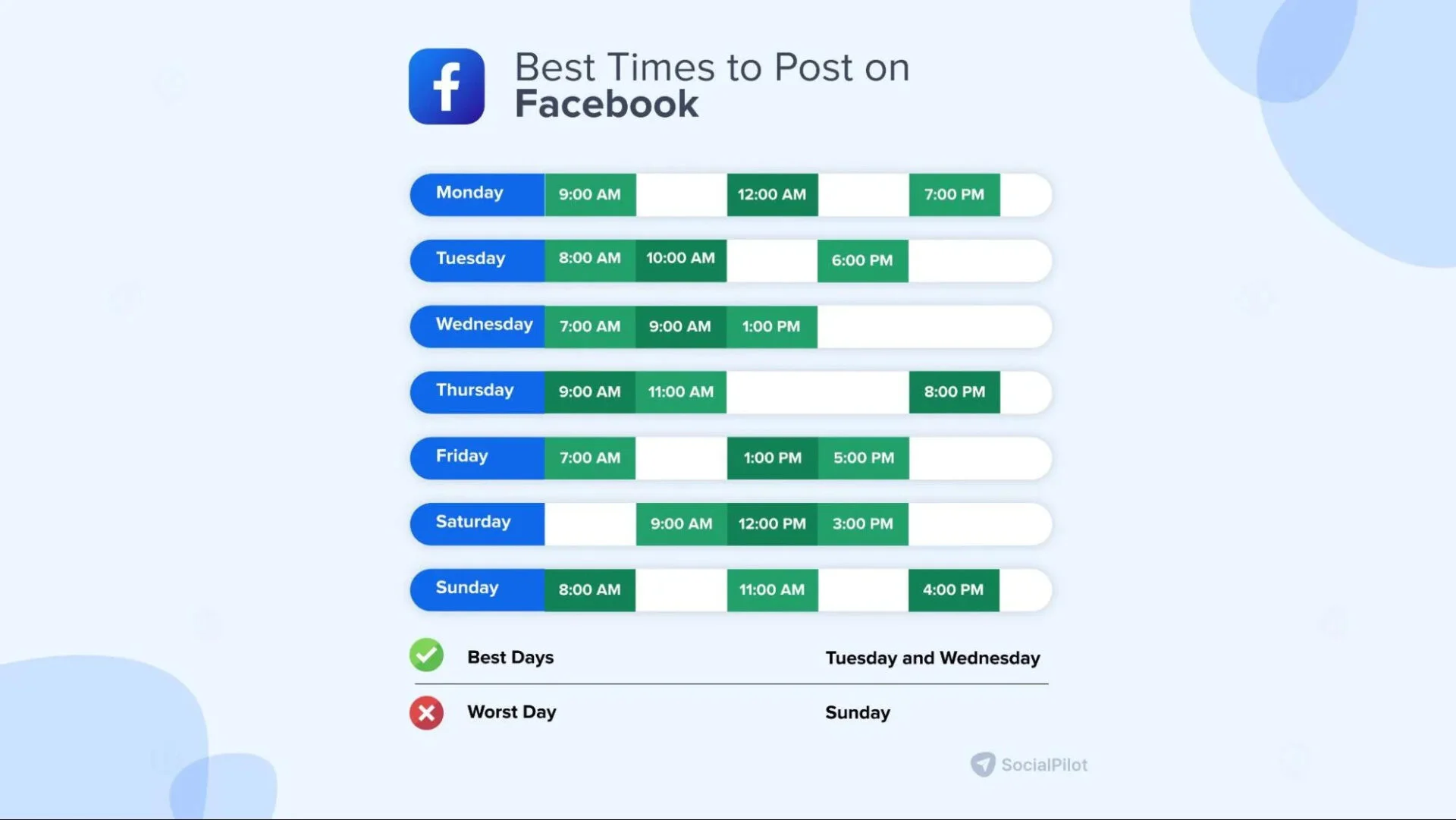
Don’t just rely on general averages. Tools like SocialPilot’s AI-Suggested Best Time to Post feature analyze your own Facebook Insights and audience demographics to recommend the exact times that work best for your page. This ensures you’re posting when your followers are most likely to engage, not just when the internet says you should.
12. Respond Quickly and Engage Back
Engagement isn’t just about getting likes or comments; it’s about keeping the conversation going. People love interacting with brands that respond because it makes them feel valued and shows there’s a real person behind the page.
Why this boosts engagement:
- Signals activity to the algorithm: Posts with active conversations get higher reach because Facebook recognizes them as valuable.
- Builds trust and loyalty: Quick, thoughtful replies make followers feel heard and appreciated.
- Encourages repeat interaction: When users know you’ll respond, they’re more likely to comment again in the future.
How to do it effectively:
- Reply to comments and messages promptly, even dedicating a few minutes a day makes a big difference.
- Acknowledge all types of engagement, from brief responses to in-depth comments.
- Ask follow-up questions to extend conversations and spark more replies.
- Use friendly, conversational language (emojis and GIFs can work well).
- Monitor posts and messages consistently to avoid missing opportunities.
Here you can see how Starbucks responds promptly to almost all comments on their Facebook posts:

Additional Tips:
- Turn on Comment Ranking feature in your Page settings so the most relevant and engaging comments appear at the top. This encourages more people to join the conversation.
- Use tools like SocialPilot’s Social Inbox to manage comments and messages across multiple platforms in one dashboard, making it faster and easier to respond without missing a beat.
13. Write Catchy Captions and Description
A post isn’t just its visuals; the caption or description plays a huge role in driving engagement. A well-crafted caption can spark curiosity, encourage comments, and even boost shares. For image posts, adding alt text ensures accessibility and improves your content’s discoverability.
Why this boosts engagement:
- Captions guide reactions: A compelling caption gives context, tells a story, or asks a question that invites interaction.
- Accessibility increases reach: Alt text allows screen readers to describe your images, making your content more inclusive and potentially discoverable.
- Encourages shares and saves: Informative or emotional captions can prompt users to save posts or share them with friends.
As you can see in the screenshot below, this brand uses simple, short, but catchy captions that stop scrollers:
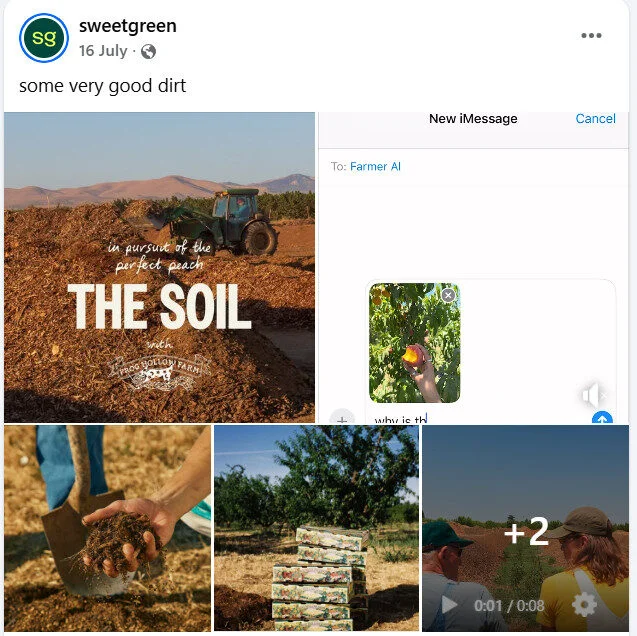
How to do it effectively:
- Keep it concise and hook-driven: Start with a strong line that grabs attention.
- Ask questions or invite action: Encourage comments with open-ended prompts or calls-to-action.
- Use storytelling: Even short posts can tell a mini story that resonates with your audience.
- Include relevant keywords sparingly: Helps with discoverability without cluttering the caption.
- Captions A/B testing: Use Facebook’s AI-driven A/B testing to try different captions and descriptions, and include relevant keywords to help the algorithm push your post to the ideal audience for higher reach and engagement.
If you’re struggling to come up with creative captions? Tools like SocialPilot’s Facebook Caption Generator can help you craft engaging captions in seconds, tailored to your niche and audience. Combine this with alt text for maximum impact on engagement.
14. Collaborate with Micro-Creators
Influencer marketing isn’t just for big brands; micro-creators with smaller but highly engaged audiences can drive massive interaction on your Facebook posts. According to GetSaral article, micro influencers (3-6% ER) posts get better engagement than macro (1-2% ER) while costing less. Collaborating with them helps you tap into communities that are already active and trust the creator’s recommendations.
Why this boosts engagement:
- Higher trust and authenticity: Micro-creators often have personal relationships with their followers and have a specific audience, which makes their endorsements more impactful.
- Better interaction rates: Smaller, niche audiences tend to comment, share, and engage more than large, generic ones.
- Wider reach: Collaborators bring their audience to your content, increasing visibility and interactions.
How to collaborate effectively:
- Identify relevant micro-creators: Look for influencers in your niche whose followers align with your target audience.
- Enable the “Invite Collaborator” feature: Meta offers collaboration features that allow you to tag or invite creators on posts or reels so that the content appears on both your page and theirs, expanding reach and engagement.
- Co-create content: Work with creators on short-form videos, Reels, product demos, or challenges that resonate with their audience.
- Engage with the collaborator’s community: Respond to comments and interact to maintain momentum.
As you can see in the image below, this is how Glossier utilises micro-influencers to effectively engage their audience.

By collaborating with multiple micro-creators over time, you can build a network effect where each new collaboration amplifies engagement and strengthens brand credibility. Utilise influencer marketing tools to identify and effectively manage the ideal creators for your campaigns.
15. Experiment with Interactive & AR Content
Interactive content continues to drive high engagement, Facebook AR (Augmented Reality) experiences are primarily used in paid ads rather than organic posts. These AR ads allow users to virtually try on products, play immersive mini-games, or apply fun filters, creating an engaging experience that encourages interaction.
Why this boosts engagement:
- Immersive experiences: 360° videos, AR filters, and product try-ons make users feel involved rather than passive viewers.
- Higher shareability: People love sharing fun, interactive content with friends, extending your reach.
- Stronger brand recall: Engaging experiences leave a lasting impression, making users more likely to return to your page.
How businesses can use it effectively:
- 360° videos: Showcase a product, event, or behind-the-scenes space in an immersive format.
- AR filters: Create branded filters for followers to try and share in Stories or posts.
- Product try-ons: Enable users to virtually test products like makeup, glasses, or apparel.
As you can see in the image below, a beauty brand is utilising Facebook’s AR feature to achieve high engagement and conversions.

Start small with one interactive element per week and track engagement. Once you find formats your audience loves, scale them consistently to maintain excitement and participation.
16. Optimize and Verify Your Facebook Page
A well-optimised and verified Facebook page signals credibility and professionalism, which encourages users to engage with your content. When your page is easy to find, informative, and trustworthy, followers are more likely to interact, comment, and share.
Why does this boost engagement?
- Credibility builds trust: Verified pages with complete information are taken more seriously by users, leading to increased interaction.
- Better visibility: Fully optimized pages appear higher in search results on Facebook and external search engines.
- Improved user experience: Clear descriptions, contact info, and call-to-action buttons make it easier for followers to connect with your brand.
How to optimize your page?
- Complete all sections: Add a profile picture, cover photo, business description, website, and contact info.
- Use a recognizable profile image: Consistent branding increases trust and recall.
- Add call-to-action buttons: Examples include “Shop Now,” “Sign Up,” or “Send Message” to encourage direct interaction.
- Pin essential posts: Keep high-value or timely posts at the top of your page for better engagement.
- Regularly update information: Ensure hours, links, and details are current.
For reference, here’s a screenshot from the PUMA Running Facebook page:
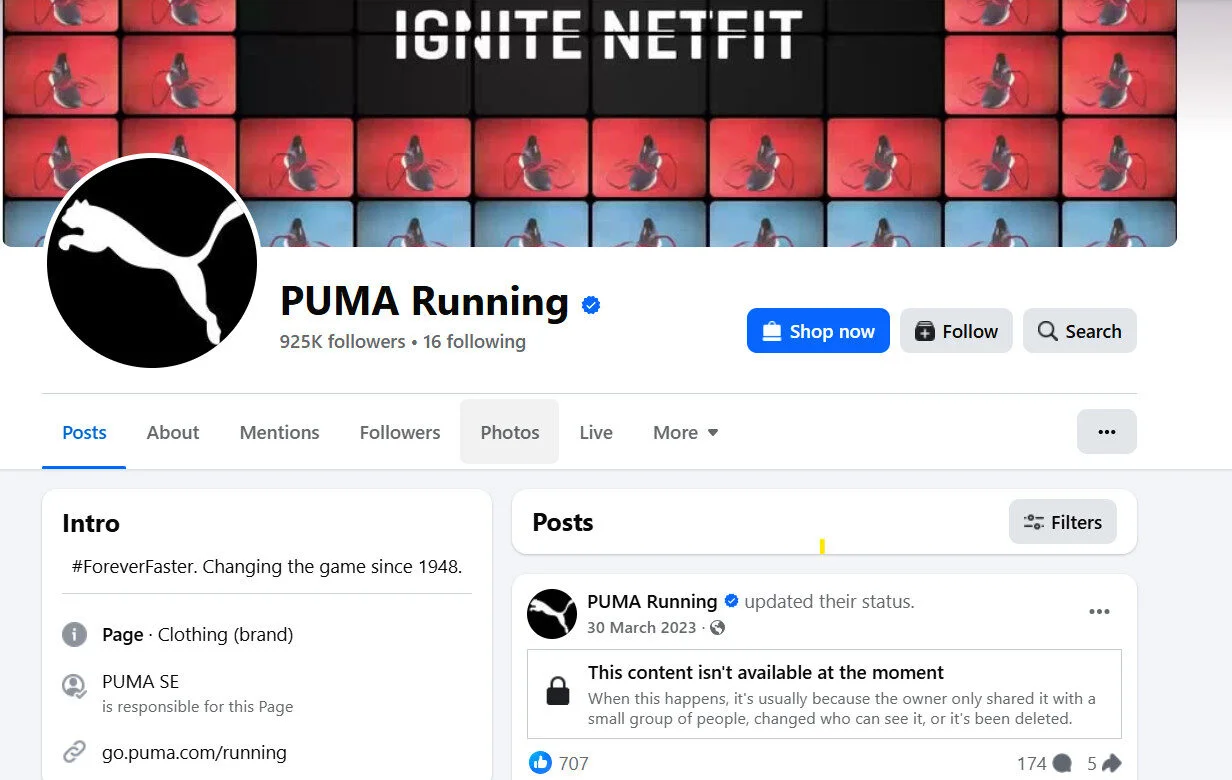
Verification benefits:
- Verified pages (blue tick) signal authenticity to followers.
- Verified status can improve algorithmic visibility, making it more likely that your content reaches your audience.
- Builds confidence for new users who are discovering your page.
Treat page optimization as ongoing. Minor updates, like refreshing visuals or adding new sections, keep your page relevant and encourage continuous engagement.
Hashtags on Facebook help your posts and Reels reach a wider, relevant audience beyond your followers. By following Facebook hashtag guidelines and using the right mix of hashtags can boost discoverability, increase engagement, and attract users who are actively interested in your niche.
Hashtag Strategy For Facebook Business Pages
To maximize engagement, use a combination of:
- Niche Hashtag: Broad category of your content. Example: #FacebookMarketing
- Topic Hashtag: Specific theme or subject of the post. Example: #FacebookEngagement
- Problem or Solution Hashtag: Highlights the benefit or problem you’re solving. Example: #HashtagStrategy
- Community Hashtag: Connects to a community or group. Example: #SocialMediaMarketers
- Trending/Seasonal Hashtag: Optional, timely tags to capitalize on trends. Example: #FacebookUpdates2025
In the image below, you can see how brands use hashtags for posting, similar to the concept we shared.

Don’t overstuff hashtags. Focus on relevant 3 to 5 targeted hashtags per post is usually optimal for Facebook engagement. And, tools like SocialPilot’s Hashtag Generator can help you discover the most relevant hashtags for your posts, tailored to your niche and audience.
Common Mistakes to Avoid with Facebook Posts
Even the best strategies can be undermined by certain mistakes. Avoiding these pitfalls ensures that your posts reach a wider audience and drive meaningful engagement.
1. Don’t Overuse AI-Generated Content
While AI tools like ChatGPT can be valuable for brainstorming, it’s essential to ensure your Facebook posts maintain a human touch. Over-reliance on AI-generated content, especially when it appears obvious, can lead to reduced engagement. Instead, leverage AI to enhance your creativity.
For instance, use AI to generate ideas or outlines, then personalize and refine them to align with your brand’s voice and resonate with your audience. For more inspiration and ready-to-use captions, explore catchy Facebook captions with proper ChatGPT prompt ideas.
2. Avoid Engagement Bait Tactics
Tactics like “Like if you agree” or “Tag a friend” are considered engagement bait and are penalized by Facebook’s algorithm. Such posts can actually reduce your reach because they encourage clicks without genuine interaction.
Instead, spark real conversations by asking thoughtful questions or posting relatable content that naturally motivates followers to comment and share. Learn more about Facebook’s engagement bait policy to ensure your posts comply and reach your audience effectively.
3. Don’t Overload with Promotional Content
Constantly posting ads or sales-heavy content can turn followers off and reduce interaction. Audiences want value, entertainment, or education, not a nonstop sales pitch. Follow the 80/20 rule: 80% of your posts should provide value, while only 20% can be promotional.
4. Avoid Long Stretches of Silence or Spamming
Inconsistent posting or large gaps between updates confuse both the algorithm and your audience, while posting too frequently can feel spammy. Stick to a consistent posting schedule and focus on quality over quantity to keep your page active and engaging.
5. Don’t Ignore Comments or Engagement
Failing to respond to comments, messages, or reactions signals a passive brand and discourages further interaction. Make it a habit to reply promptly, acknowledge feedback, and foster conversations to keep engagement high and show followers that there’s a human behind the page.
6. Don’t Ignore Video Captions and Accessibility
Videos without captions or alt text exclude users who are deaf, hard of hearing, or watching without sound, which limits engagement and discoverability. Always add captions to videos and alt text to images so your content can be understood and enjoyed by everyone, increasing overall interaction.
7. Don’t Post Unoriginal or Copied Content
Sharing content that’s copied from other creators or reused without adding value signals low effort to both your audience and Facebook. According to Facebook guidelines, it can reduce reach, engagement, and even risk penalization. Always create original content, give credit where due, and add your unique perspective to keep followers interested and the algorithm favoring your posts.
For a complete roadmap to growing your business on Facebook, explore our ultimate Facebook Marketing Guide packed with strategies, tips, and tools for success.
Turn Strategies into Real Engagement Results
Boosting Facebook engagement in 2025 requires a combination of creativity, consistency, and strategic planning. From leveraging Reels and Stories, hosting Live sessions, and building communities, to crafting captivating captions, using hashtags wisely, and responding promptly to your audience – every action counts. Avoid common pitfalls like over-promotion, engagement bait, and unoriginal content, and focus on delivering value that resonates with your followers.
Implementing these strategies not only increases likes, comments, shares, and saves but also strengthens your brand’s credibility and builds a loyal community around your business.
To make managing all your social media engagement easier, tools like SocialPilot allow you to schedule posts, respond to comments and messages, track performance, and optimize content – all from a single dashboard. Explore our pricing plans to find the package that suits your business and start boosting your Facebook engagement today.

